Strategic Management BUS349: A Case Study of Zara's Global Expansion
VerifiedAdded on 2023/06/15
|8
|1307
|468
Case Study
AI Summary
This case study provides a strategic analysis of Zara, a leading fashion retailer owned by Inditex. It examines the external business environment, highlighting opportunities for further expansion in Asia and online channels, as well as threats from competitors and economic downturns. The internal analysis identifies strengths such as brand reputation, efficient supply chain, and competitive pricing, alongside weaknesses like limited promotional activities and lack of patented designs. The study suggests focusing resources on digital marketing and e-commerce to gain a competitive advantage, supported by Ansoff Matrix analysis indicating a market development strategy. The assignment includes competitor analysis, growth trends, and strategic recommendations for Zara to enhance its market position. Desklib offers a wealth of similar solved assignments and past papers to aid students in their studies.
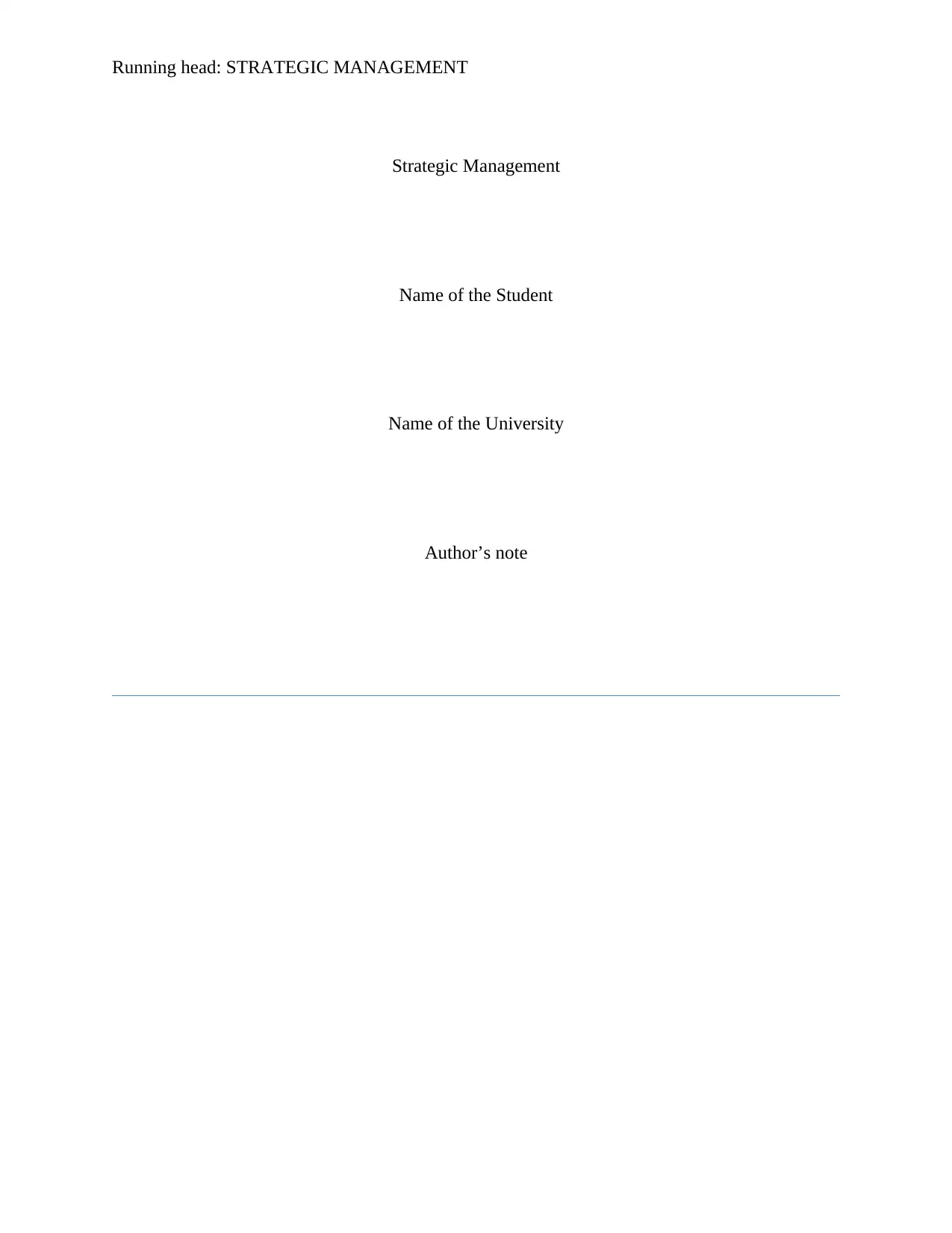
Running head: STRATEGIC MANAGEMENT
Strategic Management
Name of the Student
Name of the University
Author’s note
Strategic Management
Name of the Student
Name of the University
Author’s note
Paraphrase This Document
Need a fresh take? Get an instant paraphrase of this document with our AI Paraphraser
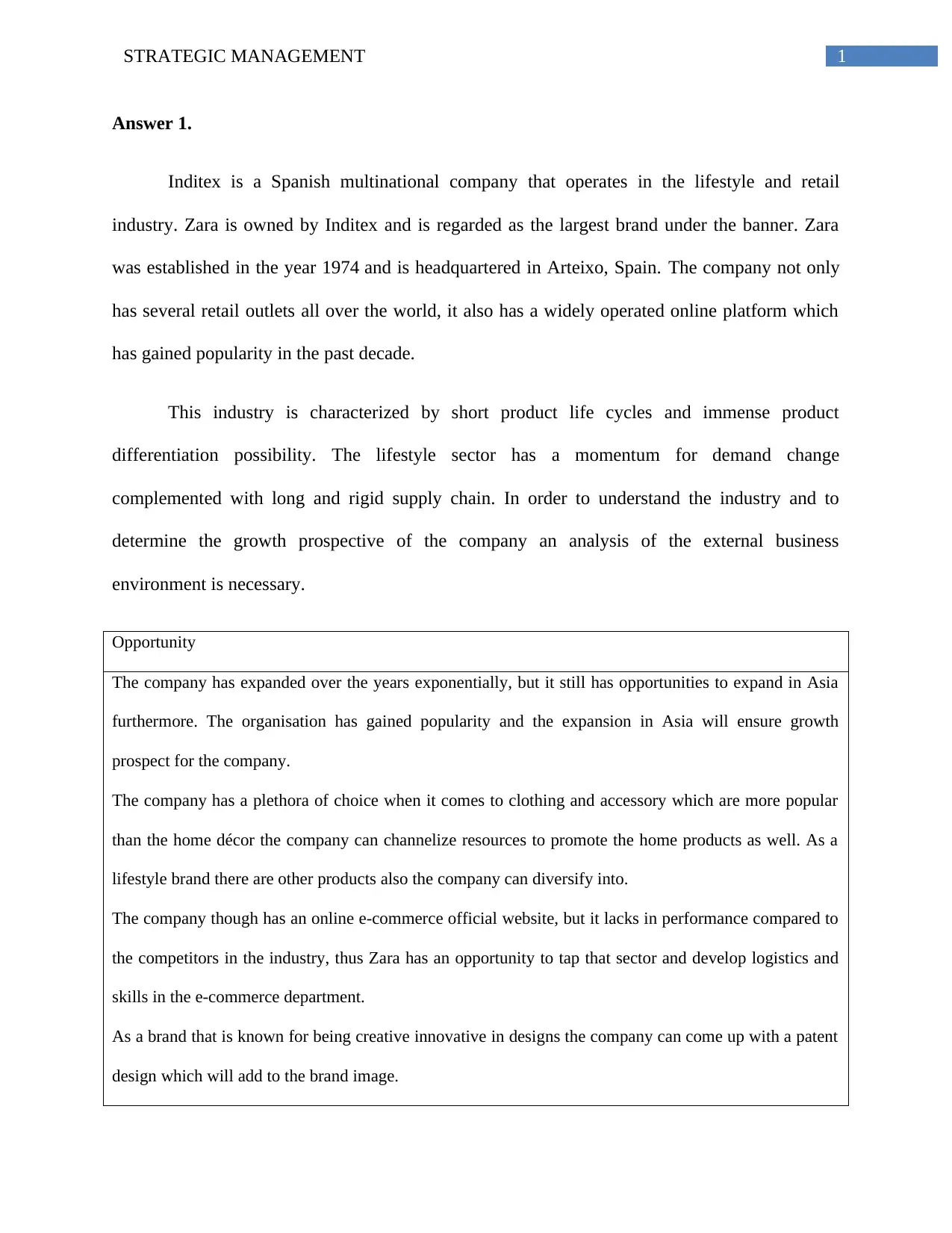
1STRATEGIC MANAGEMENT
Answer 1.
Inditex is a Spanish multinational company that operates in the lifestyle and retail
industry. Zara is owned by Inditex and is regarded as the largest brand under the banner. Zara
was established in the year 1974 and is headquartered in Arteixo, Spain. The company not only
has several retail outlets all over the world, it also has a widely operated online platform which
has gained popularity in the past decade.
This industry is characterized by short product life cycles and immense product
differentiation possibility. The lifestyle sector has a momentum for demand change
complemented with long and rigid supply chain. In order to understand the industry and to
determine the growth prospective of the company an analysis of the external business
environment is necessary.
Opportunity
The company has expanded over the years exponentially, but it still has opportunities to expand in Asia
furthermore. The organisation has gained popularity and the expansion in Asia will ensure growth
prospect for the company.
The company has a plethora of choice when it comes to clothing and accessory which are more popular
than the home décor the company can channelize resources to promote the home products as well. As a
lifestyle brand there are other products also the company can diversify into.
The company though has an online e-commerce official website, but it lacks in performance compared to
the competitors in the industry, thus Zara has an opportunity to tap that sector and develop logistics and
skills in the e-commerce department.
As a brand that is known for being creative innovative in designs the company can come up with a patent
design which will add to the brand image.
Answer 1.
Inditex is a Spanish multinational company that operates in the lifestyle and retail
industry. Zara is owned by Inditex and is regarded as the largest brand under the banner. Zara
was established in the year 1974 and is headquartered in Arteixo, Spain. The company not only
has several retail outlets all over the world, it also has a widely operated online platform which
has gained popularity in the past decade.
This industry is characterized by short product life cycles and immense product
differentiation possibility. The lifestyle sector has a momentum for demand change
complemented with long and rigid supply chain. In order to understand the industry and to
determine the growth prospective of the company an analysis of the external business
environment is necessary.
Opportunity
The company has expanded over the years exponentially, but it still has opportunities to expand in Asia
furthermore. The organisation has gained popularity and the expansion in Asia will ensure growth
prospect for the company.
The company has a plethora of choice when it comes to clothing and accessory which are more popular
than the home décor the company can channelize resources to promote the home products as well. As a
lifestyle brand there are other products also the company can diversify into.
The company though has an online e-commerce official website, but it lacks in performance compared to
the competitors in the industry, thus Zara has an opportunity to tap that sector and develop logistics and
skills in the e-commerce department.
As a brand that is known for being creative innovative in designs the company can come up with a patent
design which will add to the brand image.
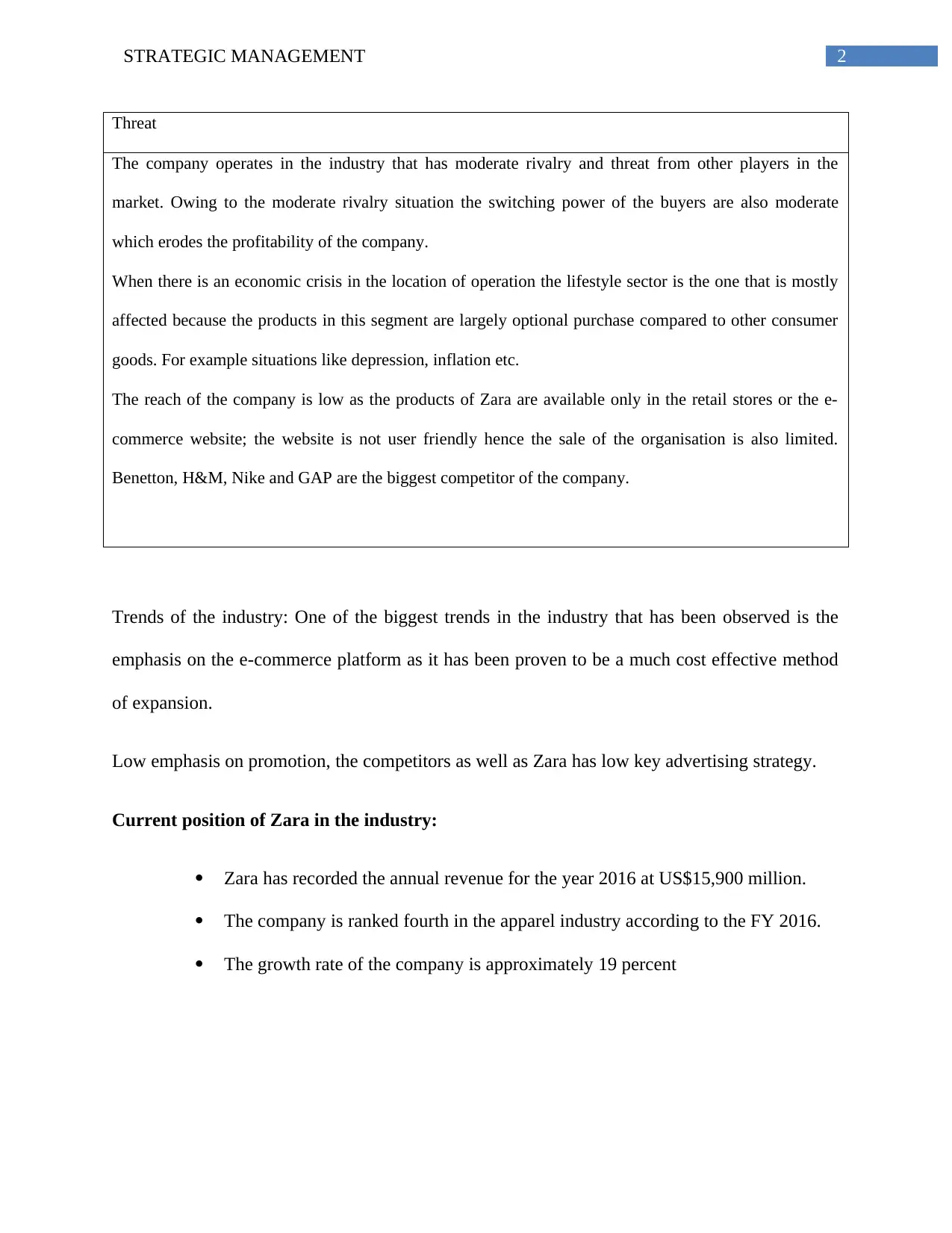
2STRATEGIC MANAGEMENT
Threat
The company operates in the industry that has moderate rivalry and threat from other players in the
market. Owing to the moderate rivalry situation the switching power of the buyers are also moderate
which erodes the profitability of the company.
When there is an economic crisis in the location of operation the lifestyle sector is the one that is mostly
affected because the products in this segment are largely optional purchase compared to other consumer
goods. For example situations like depression, inflation etc.
The reach of the company is low as the products of Zara are available only in the retail stores or the e-
commerce website; the website is not user friendly hence the sale of the organisation is also limited.
Benetton, H&M, Nike and GAP are the biggest competitor of the company.
Trends of the industry: One of the biggest trends in the industry that has been observed is the
emphasis on the e-commerce platform as it has been proven to be a much cost effective method
of expansion.
Low emphasis on promotion, the competitors as well as Zara has low key advertising strategy.
Current position of Zara in the industry:
Zara has recorded the annual revenue for the year 2016 at US$15,900 million.
The company is ranked fourth in the apparel industry according to the FY 2016.
The growth rate of the company is approximately 19 percent
Threat
The company operates in the industry that has moderate rivalry and threat from other players in the
market. Owing to the moderate rivalry situation the switching power of the buyers are also moderate
which erodes the profitability of the company.
When there is an economic crisis in the location of operation the lifestyle sector is the one that is mostly
affected because the products in this segment are largely optional purchase compared to other consumer
goods. For example situations like depression, inflation etc.
The reach of the company is low as the products of Zara are available only in the retail stores or the e-
commerce website; the website is not user friendly hence the sale of the organisation is also limited.
Benetton, H&M, Nike and GAP are the biggest competitor of the company.
Trends of the industry: One of the biggest trends in the industry that has been observed is the
emphasis on the e-commerce platform as it has been proven to be a much cost effective method
of expansion.
Low emphasis on promotion, the competitors as well as Zara has low key advertising strategy.
Current position of Zara in the industry:
Zara has recorded the annual revenue for the year 2016 at US$15,900 million.
The company is ranked fourth in the apparel industry according to the FY 2016.
The growth rate of the company is approximately 19 percent
⊘ This is a preview!⊘
Do you want full access?
Subscribe today to unlock all pages.

Trusted by 1+ million students worldwide
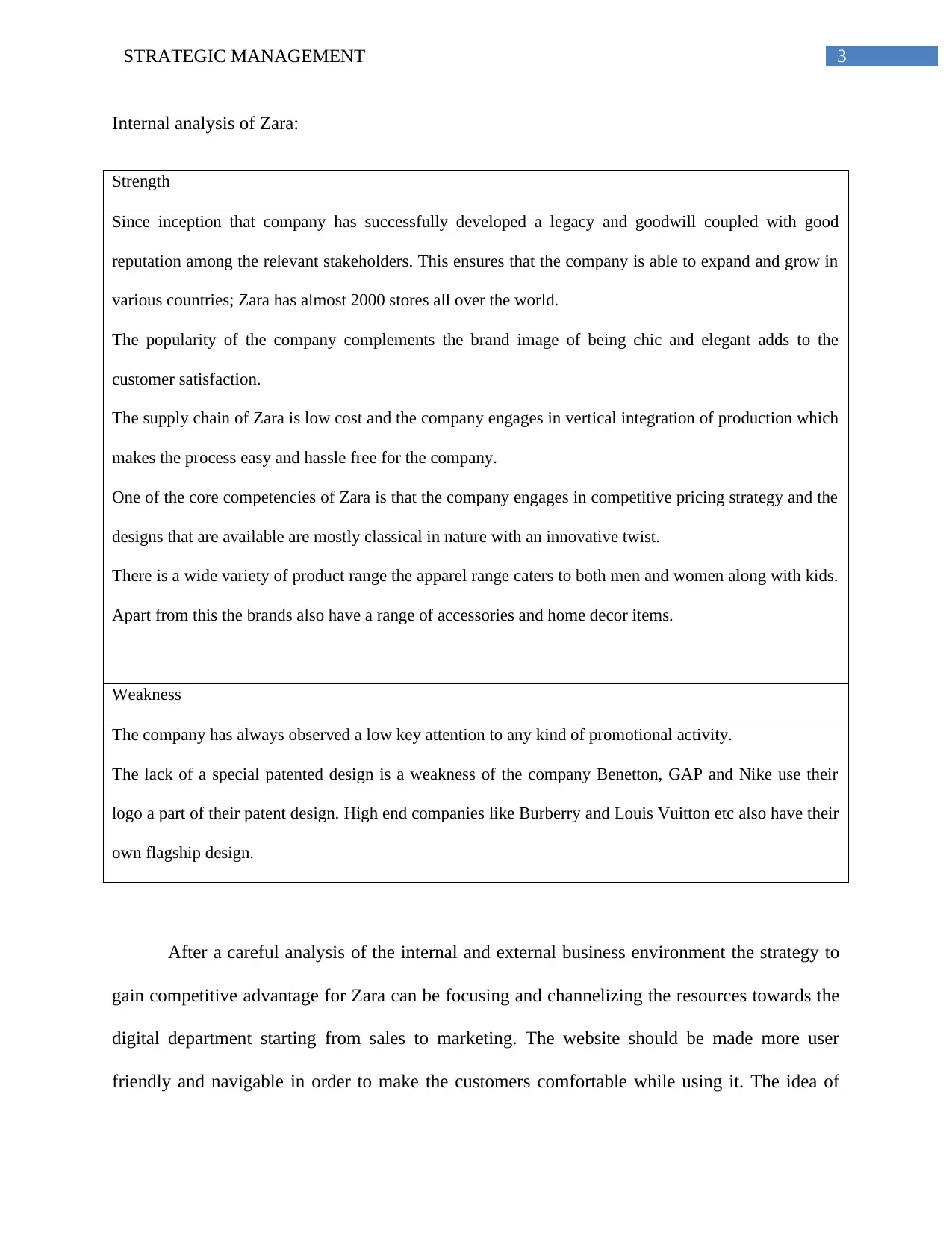
3STRATEGIC MANAGEMENT
Internal analysis of Zara:
Strength
Since inception that company has successfully developed a legacy and goodwill coupled with good
reputation among the relevant stakeholders. This ensures that the company is able to expand and grow in
various countries; Zara has almost 2000 stores all over the world.
The popularity of the company complements the brand image of being chic and elegant adds to the
customer satisfaction.
The supply chain of Zara is low cost and the company engages in vertical integration of production which
makes the process easy and hassle free for the company.
One of the core competencies of Zara is that the company engages in competitive pricing strategy and the
designs that are available are mostly classical in nature with an innovative twist.
There is a wide variety of product range the apparel range caters to both men and women along with kids.
Apart from this the brands also have a range of accessories and home decor items.
Weakness
The company has always observed a low key attention to any kind of promotional activity.
The lack of a special patented design is a weakness of the company Benetton, GAP and Nike use their
logo a part of their patent design. High end companies like Burberry and Louis Vuitton etc also have their
own flagship design.
After a careful analysis of the internal and external business environment the strategy to
gain competitive advantage for Zara can be focusing and channelizing the resources towards the
digital department starting from sales to marketing. The website should be made more user
friendly and navigable in order to make the customers comfortable while using it. The idea of
Internal analysis of Zara:
Strength
Since inception that company has successfully developed a legacy and goodwill coupled with good
reputation among the relevant stakeholders. This ensures that the company is able to expand and grow in
various countries; Zara has almost 2000 stores all over the world.
The popularity of the company complements the brand image of being chic and elegant adds to the
customer satisfaction.
The supply chain of Zara is low cost and the company engages in vertical integration of production which
makes the process easy and hassle free for the company.
One of the core competencies of Zara is that the company engages in competitive pricing strategy and the
designs that are available are mostly classical in nature with an innovative twist.
There is a wide variety of product range the apparel range caters to both men and women along with kids.
Apart from this the brands also have a range of accessories and home decor items.
Weakness
The company has always observed a low key attention to any kind of promotional activity.
The lack of a special patented design is a weakness of the company Benetton, GAP and Nike use their
logo a part of their patent design. High end companies like Burberry and Louis Vuitton etc also have their
own flagship design.
After a careful analysis of the internal and external business environment the strategy to
gain competitive advantage for Zara can be focusing and channelizing the resources towards the
digital department starting from sales to marketing. The website should be made more user
friendly and navigable in order to make the customers comfortable while using it. The idea of
Paraphrase This Document
Need a fresh take? Get an instant paraphrase of this document with our AI Paraphraser
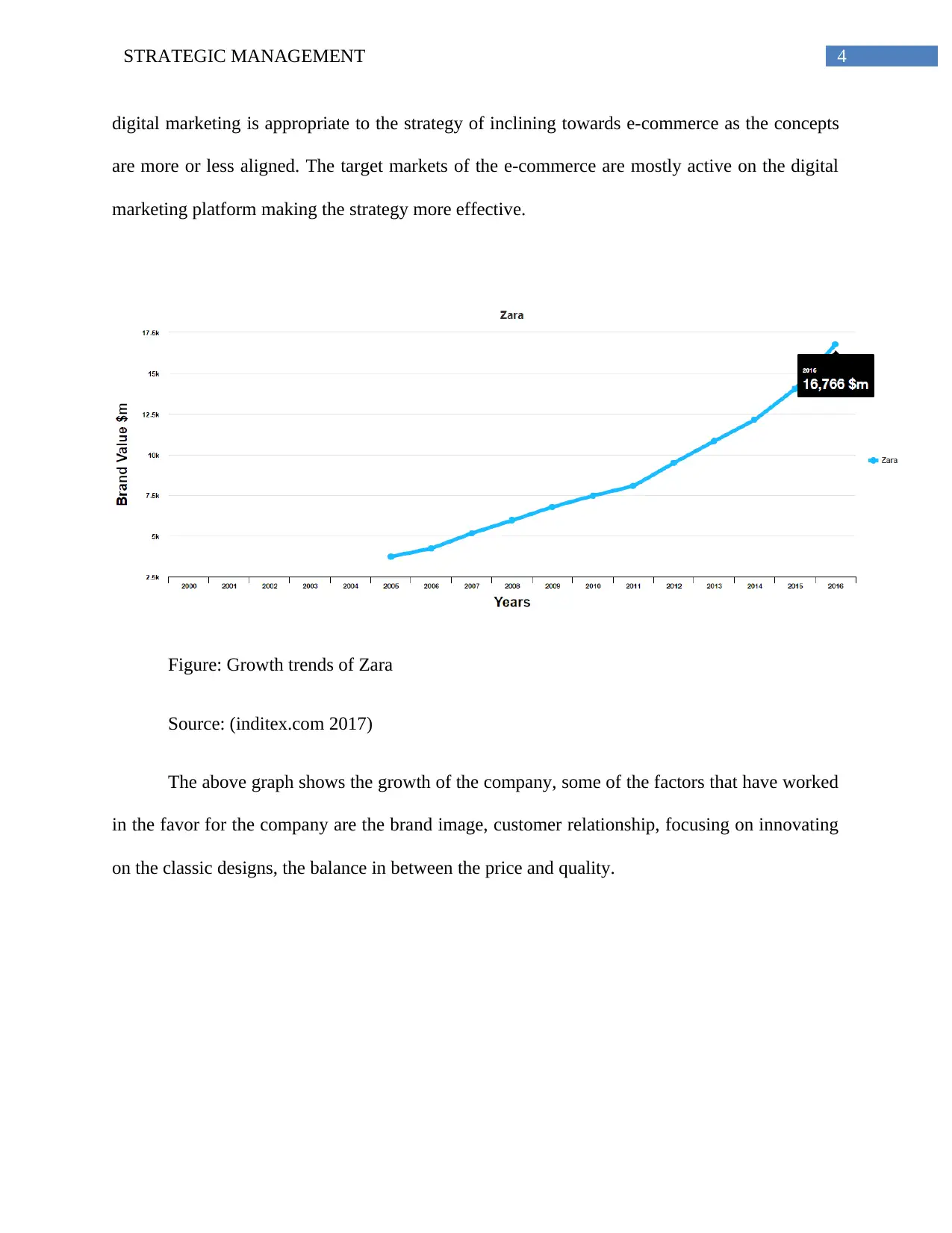
4STRATEGIC MANAGEMENT
digital marketing is appropriate to the strategy of inclining towards e-commerce as the concepts
are more or less aligned. The target markets of the e-commerce are mostly active on the digital
marketing platform making the strategy more effective.
Figure: Growth trends of Zara
Source: (inditex.com 2017)
The above graph shows the growth of the company, some of the factors that have worked
in the favor for the company are the brand image, customer relationship, focusing on innovating
on the classic designs, the balance in between the price and quality.
digital marketing is appropriate to the strategy of inclining towards e-commerce as the concepts
are more or less aligned. The target markets of the e-commerce are mostly active on the digital
marketing platform making the strategy more effective.
Figure: Growth trends of Zara
Source: (inditex.com 2017)
The above graph shows the growth of the company, some of the factors that have worked
in the favor for the company are the brand image, customer relationship, focusing on innovating
on the classic designs, the balance in between the price and quality.
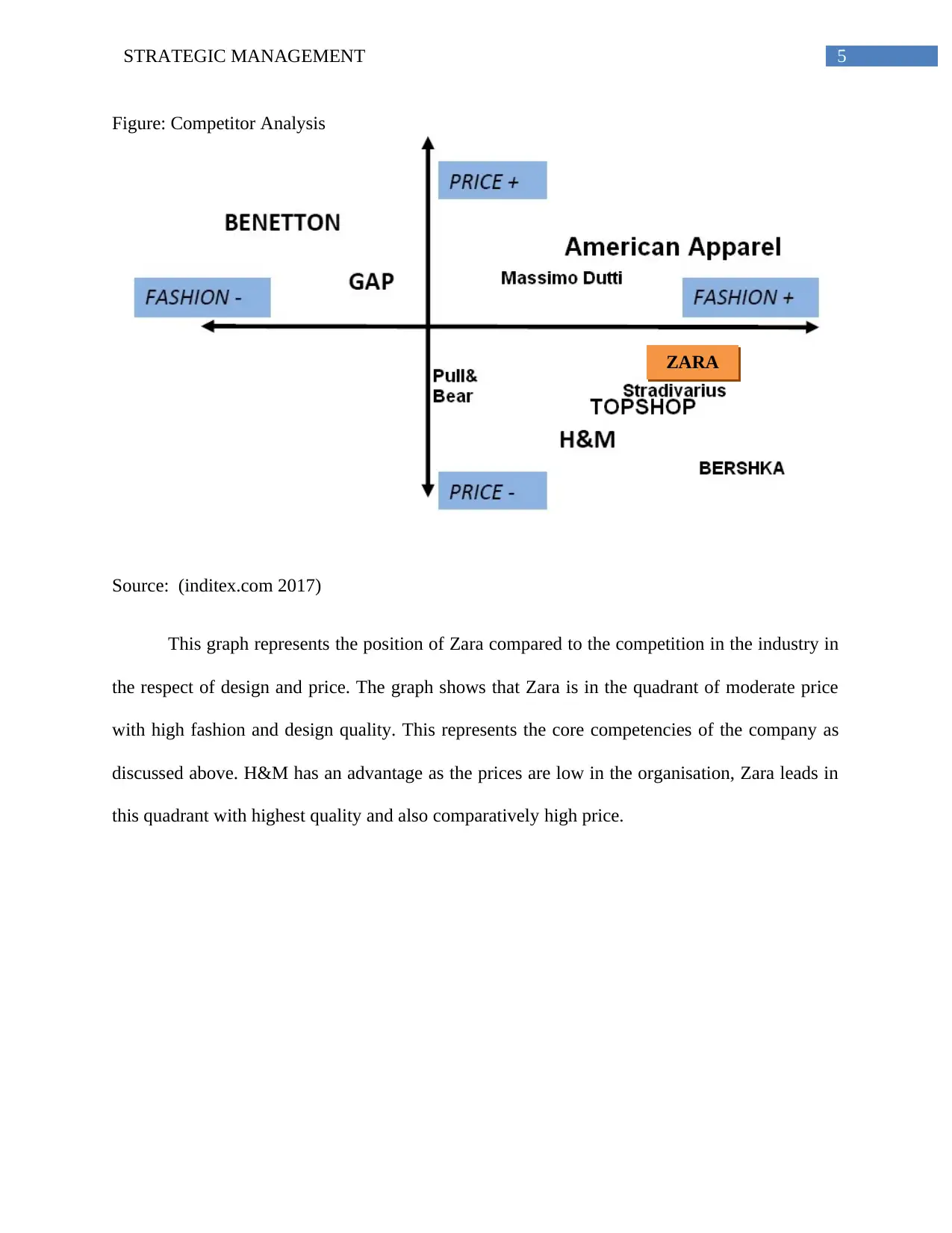
5STRATEGIC MANAGEMENT
Figure: Competitor Analysis
Source: (inditex.com 2017)
This graph represents the position of Zara compared to the competition in the industry in
the respect of design and price. The graph shows that Zara is in the quadrant of moderate price
with high fashion and design quality. This represents the core competencies of the company as
discussed above. H&M has an advantage as the prices are low in the organisation, Zara leads in
this quadrant with highest quality and also comparatively high price.
ZARA
Figure: Competitor Analysis
Source: (inditex.com 2017)
This graph represents the position of Zara compared to the competition in the industry in
the respect of design and price. The graph shows that Zara is in the quadrant of moderate price
with high fashion and design quality. This represents the core competencies of the company as
discussed above. H&M has an advantage as the prices are low in the organisation, Zara leads in
this quadrant with highest quality and also comparatively high price.
ZARA
⊘ This is a preview!⊘
Do you want full access?
Subscribe today to unlock all pages.

Trusted by 1+ million students worldwide
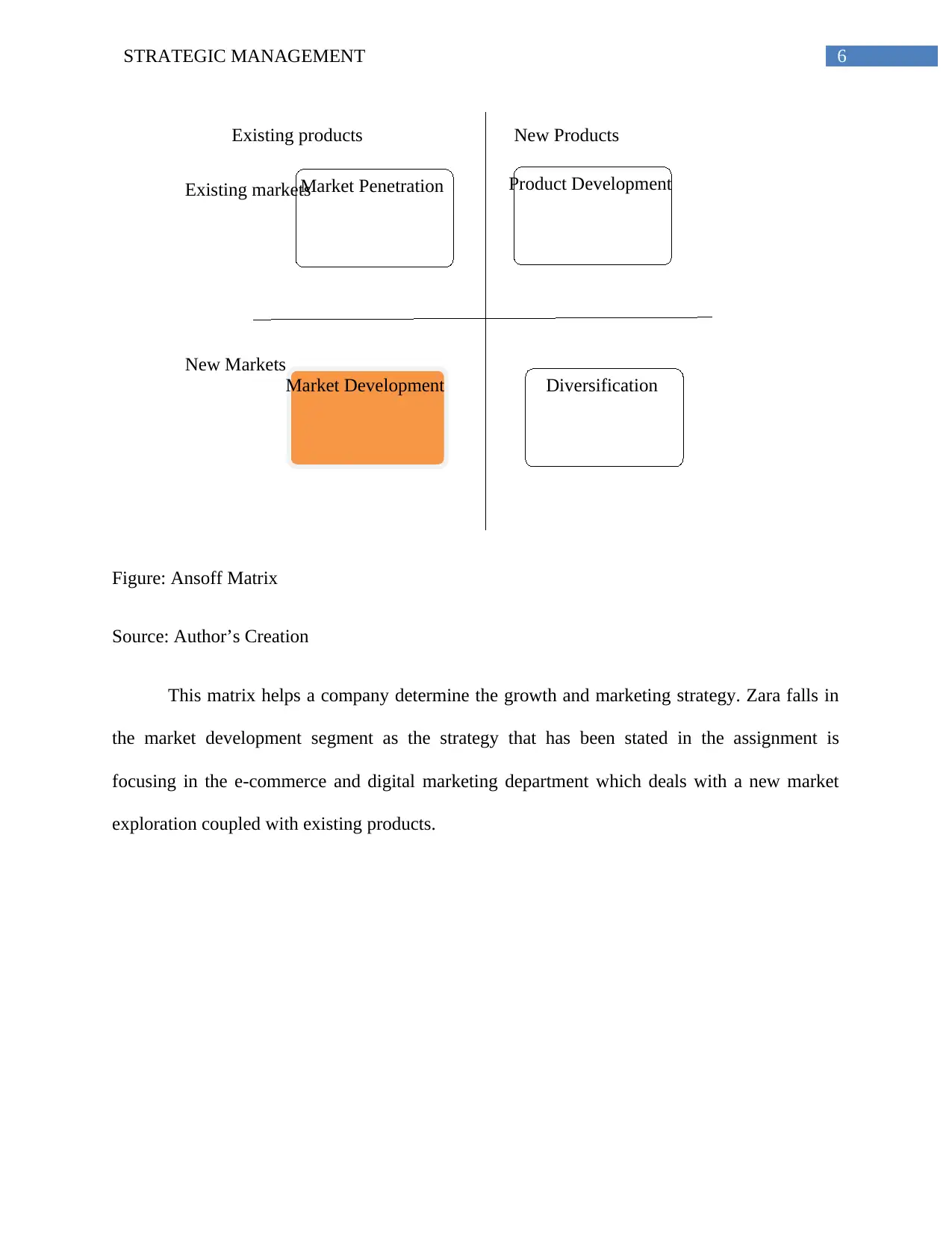
6STRATEGIC MANAGEMENT
Market Penetration Product Development
Market Development Diversification
Existing products New Products
Existing markets
New Markets
Figure: Ansoff Matrix
Source: Author’s Creation
This matrix helps a company determine the growth and marketing strategy. Zara falls in
the market development segment as the strategy that has been stated in the assignment is
focusing in the e-commerce and digital marketing department which deals with a new market
exploration coupled with existing products.
Market Penetration Product Development
Market Development Diversification
Existing products New Products
Existing markets
New Markets
Figure: Ansoff Matrix
Source: Author’s Creation
This matrix helps a company determine the growth and marketing strategy. Zara falls in
the market development segment as the strategy that has been stated in the assignment is
focusing in the e-commerce and digital marketing department which deals with a new market
exploration coupled with existing products.
Paraphrase This Document
Need a fresh take? Get an instant paraphrase of this document with our AI Paraphraser
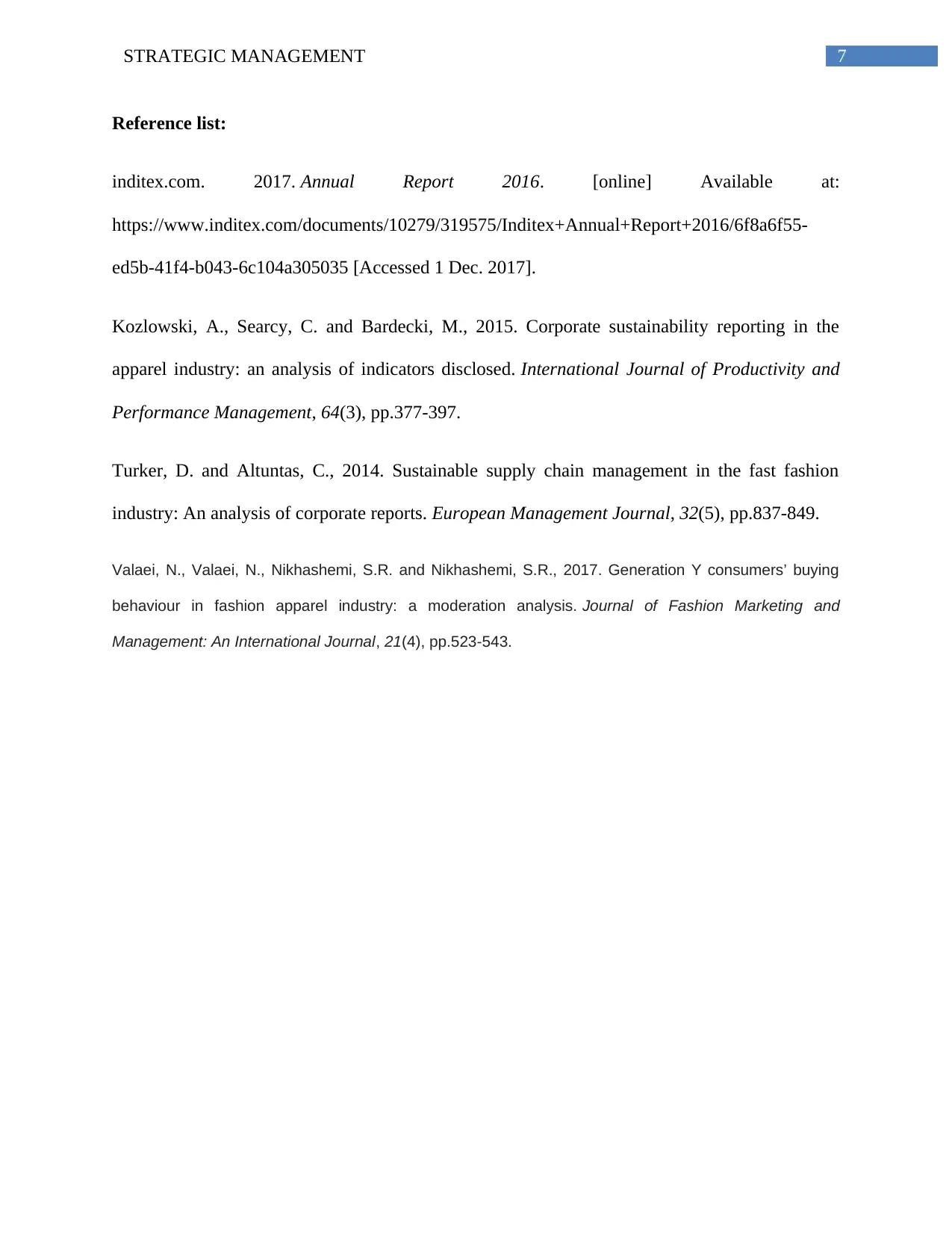
7STRATEGIC MANAGEMENT
Reference list:
inditex.com. 2017. Annual Report 2016. [online] Available at:
https://www.inditex.com/documents/10279/319575/Inditex+Annual+Report+2016/6f8a6f55-
ed5b-41f4-b043-6c104a305035 [Accessed 1 Dec. 2017].
Kozlowski, A., Searcy, C. and Bardecki, M., 2015. Corporate sustainability reporting in the
apparel industry: an analysis of indicators disclosed. International Journal of Productivity and
Performance Management, 64(3), pp.377-397.
Turker, D. and Altuntas, C., 2014. Sustainable supply chain management in the fast fashion
industry: An analysis of corporate reports. European Management Journal, 32(5), pp.837-849.
Valaei, N., Valaei, N., Nikhashemi, S.R. and Nikhashemi, S.R., 2017. Generation Y consumers’ buying
behaviour in fashion apparel industry: a moderation analysis. Journal of Fashion Marketing and
Management: An International Journal, 21(4), pp.523-543.
Reference list:
inditex.com. 2017. Annual Report 2016. [online] Available at:
https://www.inditex.com/documents/10279/319575/Inditex+Annual+Report+2016/6f8a6f55-
ed5b-41f4-b043-6c104a305035 [Accessed 1 Dec. 2017].
Kozlowski, A., Searcy, C. and Bardecki, M., 2015. Corporate sustainability reporting in the
apparel industry: an analysis of indicators disclosed. International Journal of Productivity and
Performance Management, 64(3), pp.377-397.
Turker, D. and Altuntas, C., 2014. Sustainable supply chain management in the fast fashion
industry: An analysis of corporate reports. European Management Journal, 32(5), pp.837-849.
Valaei, N., Valaei, N., Nikhashemi, S.R. and Nikhashemi, S.R., 2017. Generation Y consumers’ buying
behaviour in fashion apparel industry: a moderation analysis. Journal of Fashion Marketing and
Management: An International Journal, 21(4), pp.523-543.
1 out of 8
Related Documents
Your All-in-One AI-Powered Toolkit for Academic Success.
+13062052269
info@desklib.com
Available 24*7 on WhatsApp / Email
![[object Object]](/_next/static/media/star-bottom.7253800d.svg)
Unlock your academic potential
Copyright © 2020–2025 A2Z Services. All Rights Reserved. Developed and managed by ZUCOL.





